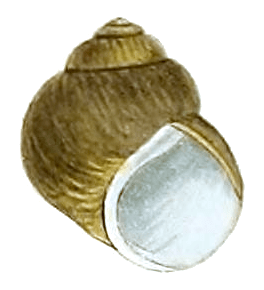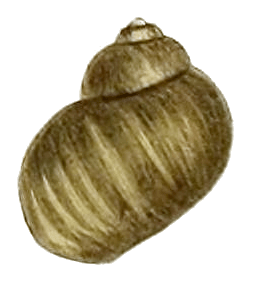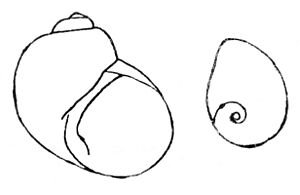Gravel snail facts for kids
The gravel snail, known scientifically as Lithoglyphus naticoides, is a small freshwater snail. It has a special lid called an operculum that can close its shell opening. This snail is an aquatic gastropod mollusk and belongs to the family Lithoglyphidae.
Lithoglyphus naticoides is the main example, or type species, for its group, the Lithoglyphus genus.
Quick facts for kids Gravel snail |
|
|---|---|
 |
|
| Live individuals of Lithoglyphus naticoides | |
| Conservation status | |
| Scientific classification | |
| Synonyms | |
|
Paludina naticoides C. Pfeiffer, 1828 |
Contents
Where Gravel Snails Live
Long ago, during the Pliocene epoch (which was millions of years ago), the gravel snail lived across a wide area. This stretched from Western Europe all the way to Western Siberia. When the weather got colder, their living area became smaller, mostly around the Black Sea and Azov Sea.
Today, these snails are naturally found in the Black Sea region. This includes rivers flowing into the Black Sea and the Danube River, reaching as far as Regensburg in central Europe.
Over time, people accidentally or purposefully moved these snails to other parts of Europe. After the year 1800, they were introduced to the Elbe and Rhine river areas.
Sadly, after 1960, many gravel snails in central Europe almost disappeared. This was mainly because of water pollution.
You can find this snail in many countries, including:
- In Western Europe: Netherlands and France.
- In Central Europe: Austria, Czech Republic (where they are endangered in Moravia), Germany (highly endangered, especially in Sachsen-Anhalt and Baden-Württemberg), Poland (where they are endangered and not native), and Slovakia.
- In Eastern Europe: Latvia, Lithuania, Belarus, Ukraine, Russia (they spread in the Volga river delta and reservoirs like Volgograd Reservoir and Kuybyshev Reservoir), and Turkey.
- In Asia: They have been found in the Bukhtarminskoe Reservoir on the Irtysh River in Kazakhstan. Here, they can be very numerous, with up to 700 snails found in just one square meter!
- In North America: They have also been found in the Great Lakes.
What Gravel Snails Look Like
The name "naticoides" means that this snail looks a bit like the marine moon snails, which belong to the Naticidae family. Both the shell and the operculum (the lid) of the gravel snail remind people of these ocean snails.
The shell of the gravel snail is round, like a globe. It can be light grey, greenish-yellow, or dark. It has about 4.5 to 5 whorls, which are the turns of the shell. The largest turn, called the last whorl, is the most noticeable part. The shell is usually about 7–10 millimeters tall and 7–10 millimeters wide. Sometimes, it's about 6.5–8 millimeters wide and 7–9 millimeters tall.
The snail itself has a wide "foot" that it uses to move around. Male snails are often smaller than female snails.
Gravel Snail Life and Habitat
Gravel snails live in many different freshwater places. You can find them in rivers, lakes, channels, and large reservoirs. In rivers, they prefer spots where the water doesn't flow too fast. They like to live on solid muddy ground and among stones. These snails need water with lots of oxygen and calcium carbonate to survive. In some places, their populations can be very dense, with up to 3,300 snails found in just one square meter! They can also live in slightly salty water, up to 3 parts per thousand of salinity.
Lithoglyphus naticoides mostly eats tiny diatomes and green alga.
The entire life cycle of a gravel snail usually takes about one year. They mostly reproduce in July. Scientists have studied and described what their egg capsules look like. A gravel snail can live for about 4 to 5 years.
Sometimes, other tiny creatures, called parasites, live inside the gravel snail. The snail acts as a first "intermediate host" for some of these parasites. This means the parasite lives part of its life cycle inside the snail before moving to another animal. Some of these parasites include Nicolla skrjabini, Apophallus muehlingi, and Apophallus donicus.
How Humans Have Used Gravel Snails
Long, long ago, during the Neolithic period (the New Stone Age), people used the shells of Lithoglyphus naticoides. Scientists found snail shells with holes in them in an ancient grave in Lower Austria. These shells were likely used as decorations, perhaps on someone's head.





